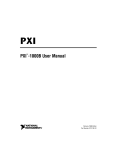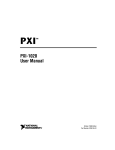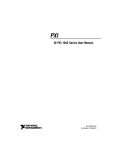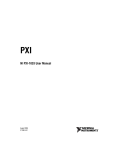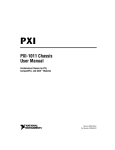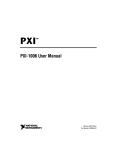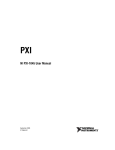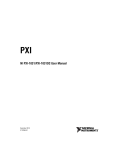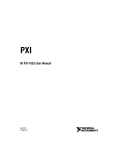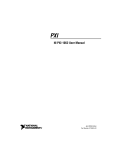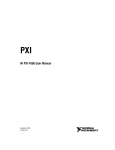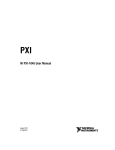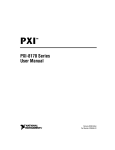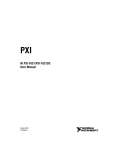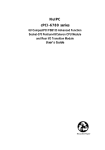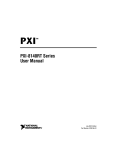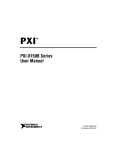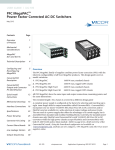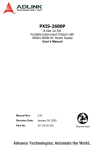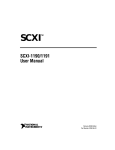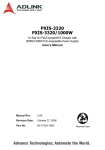Download PXI-1025 MegaPAC (TM) User Manual
Transcript
PXI ™ PXI-1025 MegaPAC™ User Manual PXI-1025 MegaPAC User Manual July 2000 Edition Part Number 322532B-01 Worldwide Technical Support and Product Information www.ni.com National Instruments Corporate Headquarters 11500 North Mopac Expressway Austin, Texas 78759-3504 USA Tel: 512 794 0100 Worldwide Offices Australia 03 9879 5166, Austria 0662 45 79 90 0, Belgium 02 757 00 20, Brazil 011 284 5011, Canada (Calgary) 403 274 9391, Canada (Ontario) 905 785 0085, Canada (Québec) 514 694 8521, China 0755 3904939, Denmark 45 76 26 00, Finland 09 725 725 11, France 01 48 14 24 24, Germany 089 741 31 30, Greece 30 1 42 96 427, Hong Kong 2645 3186, India 91805275406, Israel 03 6120092, Italy 02 413091, Japan 03 5472 2970, Korea 02 596 7456, Mexico (D.F.) 5 280 7625, Mexico (Monterrey) 8 357 7695, Netherlands 0348 433466, New Zealand 09 914 0488, Norway 32 27 73 00, Poland 0 22 528 94 06, Portugal 351 1 726 9011, Singapore 2265886, Spain 91 640 0085, Sweden 08 587 895 00, Switzerland 056 200 51 51, Taiwan 02 2528 7227, United Kingdom 01635 523545 For further support information, see the Technical Support Resources appendix. To comment on the documentation, send e-mail to [email protected] © Copyright 1999, 2000 National Instruments Corporation. All rights reserved. Important Information Warranty The PXI-1025 MegaPAC is warranted against defects in materials and workmanship for a period of one year from the date of shipment, as evidenced by receipts or other documentation. National Instruments will, at its option, repair or replace equipment that proves to be defective during the warranty period. This warranty includes parts and labor. The media on which you receive National Instruments software are warranted not to fail to execute programming instructions, due to defects in materials and workmanship, for a period of 90 days from date of shipment, as evidenced by receipts or other documentation. National Instruments will, at its option, repair or replace software media that do not execute programming instructions if National Instruments receives notice of such defects during the warranty period. National Instruments does not warrant that the operation of the software shall be uninterrupted or error free. A Return Material Authorization (RMA) number must be obtained from the factory and clearly marked on the outside of the package before any equipment will be accepted for warranty work. National Instruments will pay the shipping costs of returning to the owner parts which are covered by warranty. National Instruments believes that the information in this document is accurate. The document has been carefully reviewed for technical accuracy. In the event that technical or typographical errors exist, National Instruments reserves the right to make changes to subsequent editions of this document without prior notice to holders of this edition. The reader should consult National Instruments if errors are suspected. In no event shall National Instruments be liable for any damages arising out of or related to this document or the information contained in it. EXCEPT AS SPECIFIED HEREIN, NATIONAL INSTRUMENTS MAKES NO WARRANTIES , EXPRESS OR IMPLIED, AND SPECIFICALLY DISCLAIMS ANY WARRANTY OF MERCHANTABILITY OR FITNESS FOR A PARTICULAR PURPOSE . CUSTOMER ’S RIGHT TO RECOVER DAMAGES CAUSED BY FAULT OR NEGLIGENCE ON THE PART OF NATIONAL INSTRUMENTS SHALL BE LIMITED TO THE AMOUNT THERETOFORE PAID BY THE CUSTOMER . NATIONAL INSTRUMENTS WILL NOT BE LIABLE FOR DAMAGES RESULTING FROM LOSS OF DATA, PROFITS, USE OF PRODUCTS, OR INCIDENTAL OR CONSEQUENTIAL DAMAGES, EVEN IF ADVISED OF THE POSSIBILITY THEREOF. This limitation of the liability of National Instruments will apply regardless of the form of action, whether in contract or tort, including negligence. Any action against National Instruments must be brought within one year after the cause of action accrues. National Instruments shall not be liable for any delay in performance due to causes beyond its reasonable control. The warranty provided herein does not cover damages, defects, malfunctions, or service failures caused by owner’s failure to follow the National Instruments installation, operation, or maintenance instructions; owner’s modification of the product; owner’s abuse, misuse, or negligent acts; and power failure or surges, fire, flood, accident, actions of third parties, or other events outside reasonable control. Copyright Under the copyright laws, this publication may not be reproduced or transmitted in any form, electronic or mechanical, including photocopying, recording, storing in an information retrieval system, or translating, in whole or in part, without the prior written consent of National Instruments Corporation. Trademarks MegaPAC™, National Instruments™ , ni.com™, and PXI™ are trademarks of National Instruments Corporation. Product and company names mentioned herein are trademarks or trade names of their respective companies. WARNING REGARDING USE OF NATIONAL INSTRUMENTS PRODUCTS (1) NATIONAL INSTRUMENTS PRODUCTS ARE NOT DESIGNED WITH COMPONENTS AND TESTING FOR A LEVEL OF RELIABILITY SUITABLE FOR USE IN OR IN CONNECTION WITH SURGICAL IMPLANTS OR AS CRITICAL COMPONENTS IN ANY LIFE SUPPORT SYSTEMS WHOSE FAILURE TO PERFORM CAN REASONABLY BE EXPECTED TO CAUSE SIGNIFICANT INJURY TO A HUMAN. (2) IN ANY APPLICATION, INCLUDING THE ABOVE, RELIABILITY OF OPERATION OF THE SOFTWARE PRODUCTS CAN BE IMPAIRED BY ADVERSE FACTORS, INCLUDING BUT NOT LIMITED TO FLUCTUATIONS IN ELECTRICAL POWER SUPPLY, COMPUTER HARDWARE MALFUNCTIONS, COMPUTER OPERATING SYSTEM SOFTWARE FITNESS, FITNESS OF COMPILERS AND DEVELOPMENT SOFTWARE USED TO DEVELOP AN APPLICATION, INSTALLATION ERRORS, SOFTWARE AND HARDWARE COMPATIBILITY PROBLEMS, MALFUNCTIONS OR FAILURES OF ELECTRONIC MONITORING OR CONTROL DEVICES, TRANSIENT FAILURES OF ELECTRONIC SYSTEMS (HARDWARE AND/OR SOFTWARE), UNANTICIPATED USES OR MISUSES, OR ERRORS ON THE PART OF THE USER OR APPLICATIONS DESIGNER (ADVERSE FACTORS SUCH AS THESE ARE HEREAFTER COLLECTIVELY TERMED “SYSTEM FAILURES”). ANY APPLICATION WHERE A SYSTEM FAILURE WOULD CREATE A RISK OF HARM TO PROPERTY OR PERSONS (INCLUDING THE RISK OF BODILY INJURY AND DEATH) SHOULD NOT BE RELIANT SOLELY UPON ONE FORM OF ELECTRONIC SYSTEM DUE TO THE RISK OF SYSTEM FAILURE. TO AVOID DAMAGE, INJURY, OR DEATH, THE USER OR APPLICATION DESIGNER MUST TAKE REASONABLY PRUDENT STEPS TO PROTECT AGAINST SYSTEM FAILURES, INCLUDING BUT NOT LIMITED TO BACK-UP OR SHUT DOWN MECHANISMS. BECAUSE EACH END-USER SYSTEM IS CUSTOMIZED AND DIFFERS FROM NATIONAL INSTRUMENTS' TESTING PLATFORMS AND BECAUSE A USER OR APPLICATION DESIGNER MAY USE NATIONAL INSTRUMENTS PRODUCTS IN COMBINATION WITH OTHER PRODUCTS IN A MANNER NOT EVALUATED OR CONTEMPLATED BY NATIONAL INSTRUMENTS, THE USER OR APPLICATION DESIGNER IS ULTIMATELY RESPONSIBLE FOR VERIFYING AND VALIDATING THE SUITABILITY OF NATIONAL INSTRUMENTS PRODUCTS WHENEVER NATIONAL INSTRUMENTS PRODUCTS ARE INCORPORATED IN A SYSTEM OR APPLICATION, INCLUDING, WITHOUT LIMITATION, THE APPROPRIATE DESIGN, PROCESS AND SAFETY LEVEL OF SUCH SYSTEM OR APPLICATION. Compliance FCC/Canada Radio Frequency Interference Compliance* Determining FCC Class The Federal Communications Commission (FCC) has rules to protect wireless communications from interference. The FCC places digital electronics into two classes. These classes are known as Class A (for use in industrialcommercial locations only) or Class B (for use in residential or commercial locations). Depending on where it is operated, this product could be subject to restrictions in the FCC rules. (In Canada, the Department of Communications (DOC), of Industry Canada, regulates wireless interference in much the same way.) Digital electronics emit weak signals during normal operation that can affect radio, television, or other wireless products. By examining the product you purchased, you can determine the FCC Class and therefore which of the two FCC/DOC Warnings apply in the following sections. (Some products may not be labelled at all for FCC, if so the reader should then assume these are Class A devices.) FCC Class A products only display a simple warning statement of one paragraph in length regarding interference and undesired operation. Most of our products are FCC Class A. The FCC rules have restrictions regarding the locations where FCC Class A products can be operated. FCC Class B products display either a FCC ID code, starting with the letters EXN, or the FCC Class B compliance mark that appears as shown here on the right. The curious reader can consult the FCC web site http://www.fcc.gov for more information. FCC/DOC Warnings This equipment generates and uses radio frequency energy and, if not installed and used in strict accordance with the instructions in this manual and the CE Mark Declaration of Conformity**, may cause interference to radio and television reception. Classification requirements are the same for the Federal Communications Commission (FCC) and the Canadian Department of Communications (DOC). Changes or modifications not expressly approved by National Instruments could void the user’s authority to operate the equipment under the FCC Rules. Class A Federal Communications Commission This equipment has been tested and found to comply with the limits for a Class A digital device, pursuant to part 15 of the FCC Rules. These limits are designed to provide reasonable protection against harmful interference when the equipment is operated in a commercial environment. This equipment generates, uses, and can radiate radio frequency energy and, if not installed and used in accordance with the instruction manual, may cause harmful interference to radio communications. Operation of this equipment in a residential area is likely to cause harmful interference in which case the user will be required to correct the interference at his own expense. Canadian Department of Communications This Class A digital apparatus meets all requirements of the Canadian Interference-Causing Equipment Regulations. Cet appareil numérique de la classe A respecte toutes les exigences du Règlement sur le matériel brouilleur du Canada. Class B Federal Communications Commission This equipment has been tested and found to comply with the limits for a Class B digital device, pursuant to part 15 of the FCC Rules. These limits are designed to provide reasonable protection against harmful interference in a residential installation. This equipment generates, uses and can radiate radio frequency energy and, if not installed and used in accordance with the instructions, may cause harmful interference to radio communications. However, there is no guarantee that interference will not occur in a particular installation. If this equipment does cause harmful interference to radio or television reception, which can be determined by turning the equipment off and on, the user is encouraged to try to correct the interference by one or more of the following measures: • Reorient or relocate the receiving antenna. • Increase the separation between the equipment and receiver. • Connect the equipment into an outlet on a circuit different from that to which the receiver is connected. • Consult the dealer or an experienced radio/TV technician for help. Canadian Department of Communications This Class B digital apparatus meets all requirements of the Canadian Interference-Causing Equipment Regulations. Cet appareil numérique de la classe B respecte toutes les exigences du Règlement sur le matériel brouilleur du Canada. European Union - Compliance to EEC Directives Readers in the EU/EEC/EEA must refer to the Manufacturer's Declaration of Conformity (DoC) for information** pertaining to the CE Mark compliance scheme. The Manufacturer includes a DoC for most every hardware product except for those bought for OEMs, if also available from an original manufacturer that also markets in the EU, or where compliance is not required as for electrically benign apparatus or cables. * Certain exemptions may apply in the USA, see FCC Rules §15.103 Exempted devices, and §15.105(c). Also available in sections of CFR 47. ** The CE Mark Declaration of Conformity will contain important supplementary information and instructions for the user or installer. For Your Safety Before undertaking any troubleshooting, maintenance, or exploratory procedure, read carefully the WARNING and CAUTION notices. Caution This equipment contains voltage hazardous to human life and safety, and is capable of inflicting personal injury. • Chassis Grounding—The PXI-1025 MegaPAC chassis requires a connection from the premise wire safety ground to the PXI-1025 MegaPAC chassis ground. The earth safety ground must be connected during use of this equipment to minimize shock hazards. Refer to the Connecting Safety Ground section of Chapter 2, Installation, Configuration, and Operation, for instructions on connecting safety ground. • Live Circuits—Operating personnel and service personnel must not remove protective covers when operating the PXI-1025 MegaPAC. Adjustments and service to internal components must be undertaken by qualified service technicians. During service of this product, the mains connector to the premise wiring must be disconnected. Dangerous voltages may be present under certain conditions; use extreme caution. • Explosive Atmosphere—Do not operate the chassis in conditions where flammable gases are present. Under such conditions this equipment is unsafe and may ignite the gases or gas fumes. • Part Replacement—Only service this equipment with parts that are exact replacements, both electrically and mechanically. Contact National Instruments for replacement part information. Installation of parts with those that are not direct replacements may cause harm to personnel operating the chassis. Furthermore, damage or fire may occur if replacement parts are unsuitable. • Modification—Do not modify any part of the chassis from its original condition. Unsuitable modifications may result in safety hazards. Contents About This Manual Conventions ...................................................................................................................ix Related Documentation..................................................................................................ix Chapter 1 Getting Started Unpacking ......................................................................................................................1-1 What You Need to Get Started ......................................................................................1-1 Optional Equipment .......................................................................................................1-2 Rack-Mount Kit...............................................................................................1-2 Key Features ..................................................................................................................1-2 PXI-1025 Backplane Overview .....................................................................................1-4 Interoperability with CompactPCI ..................................................................1-4 System Controller Slot ....................................................................................1-4 Star Trigger Slot ..............................................................................................1-4 Peripheral Slots................................................................................................1-4 Local Bus.........................................................................................................1-4 Trigger Bus......................................................................................................1-5 System Reference Clock..................................................................................1-6 Chapter 2 Installation, Configuration, and Operation Site Considerations ........................................................................................................2-1 Using Handle/Tilt Stand for Bench-Top Application....................................................2-3 Fold-Down Keyboard ....................................................................................................2-3 Rack Mounting ..............................................................................................................2-4 Status LED Indicators ....................................................................................................2-4 Setting Fan Speed ..........................................................................................................2-4 Connecting Safety Ground.............................................................................................2-4 Connecting to Power Source..........................................................................................2-5 Installing PXI Modules ..................................................................................................2-5 Chapter 3 Maintenance Service Interval ..............................................................................................................3-1 Preparation .....................................................................................................................3-1 © National Instruments Corporation vii PXI-1025 MegaPAC User Manual Contents Cleaning......................................................................................................................... 3-1 Interior Cleaning ............................................................................................. 3-2 Exterior Cleaning ............................................................................................ 3-2 Cleaning the Fan Filter .................................................................................................. 3-2 Appendix A Specifications Appendix B Pinouts Appendix C Technical Support Resources Glossary Index Figures Figure 1-1. Figure 1-2. Figure 1-3. Front View of the PXI-1025 MegaPAC Chassis .................................. 1-3 Rear View of the PXI-1025 MegaPAC Chassis ................................... 1-3 PXI Local Bus and Star Trigger Routing.............................................. 1-5 Figure 2-1. Figure 2-2. Figure 2-3. Figure 2-4. PXI-1025 MegaPAC Chassis Airflow Side View ................................ 2-2 Using the Handle for Bench-Top Applications .................................... 2-3 Installing PXI or CompactPCI Modules ............................................... 2-6 Injector/Ejector Handle Position during Module Insertion .................. 2-6 Figure A-1. PXI-1025 MegaPAC Dimensions......................................................... A-4 Tables Table 2-1. Power Supply Troubleshooting............................................................. 2-5 Table B-1. Table B-2. Table B-3. Table B-4. Table B-5. Table B-6. P1 (J1) Connector Pinout for the System Controller Slot..................... B-2 P2 (J2) Connector Pinout for the System Controller Slot..................... B-3 P1 (J1) Connector Pinout for the Star Trigger Slot............................... B-4 P2 (J2) Connector Pinout for the Star Trigger Slot............................... B-5 P1 (J1) Connector Pinout for the Peripheral Slot.................................. B-6 P2 (J2) Connector Pinout for the Peripheral Slot.................................. B-7 PXI-1025 MegaPAC User Manual viii www.ni.com About This Manual The PXI-1025 MegaPAC User Manual describes the features of the PXI-1025 MegaPAC chassis and contains information about configuration, installing the modules, and operating the PXI-1025 MegaPAC. Conventions The following conventions appear in this manual: This icon denotes a note, which alerts you to important information. This icon denotes a caution, which advises you of precautions to take to avoid injury, data loss, or a system crash. This icon denotes a warning, which advises you of precautions to take to avoid being electrically shocked. italic Italic text denotes variables, emphasis, a cross reference, or an introduction to a key concept. This font also denotes text that is a placeholder for a word or value that you must supply. monospace Text in this font denotes text or characters that you should enter from the keyboard, sections of code, programming examples, and syntax examples. This font is also used for the proper names of disk drives, paths, directories, programs, subprograms, subroutines, device names, functions, operations, variables, filenames and extensions, and code excerpts. Related Documentation The following documents contain information that you may find helpful as you read this manual: • CompactPCI Specification PICMG 2.0 R2.1 • PXI Specification Revision 1.0 • IEEE 1101.1-1991, IEEE Standard for Mechanical Core Specifications for Microcomputers Using IEC 603-2 Connectors • IEEE 1101.10 and P1101.11, IEEE Standard for Additional Mechanical Specifications for Microcomputers Using IEEE 1101.1 Equipment Practice © National Instruments Corporation ix PXI-1025 MegaPAC User Manual 1 Getting Started This chapter describes the key features of the PXI-1025 MegaPAC chassis, lists the contents of your kit, and lists optional equipment you can order from National Instruments. Unpacking Carefully inspect the shipping container and the chassis for damage. Check for visible damage to the metal work. Check to make sure all handles, hardware, and switches are undamaged. Inspect the inner chassis for any possible damage, debris, or detached components. If damage appears to have been caused in shipment, file a claim with the carrier. Retain the packing material for possible inspection and/or reshipment. What You Need to Get Started The PXI-1025 MegaPAC kit contains the following items: ❑ PXI-1025 MegaPAC chassis ❑ Filler panels ❑ PXI-1025 MegaPAC User Manual ❑ Floppy disk with Chassis Initialization file, chassis.ini Other required equipment includes: ❑ AC power cord (contact National Instruments to order your power cord) Note AC mains supply cords used with the PXI-1025 MegaPAC must meet the requirements of ANSI/UL817 for use in the United States, CSA C22.2 21 and 49 for use in Canada, and IEC 227 or 245 for use in the European Union. AC mains power supply cords used with the PXI-1025 MegaPAC in other countries must be approved by the authority having jurisdiction in that country. © National Instruments Corporation 1-1 PXI-1025 MegaPAC User Manual Chapter 1 Getting Started Optional Equipment Rack-Mount Kit An optional rack-mount kit is available from National Instruments. This kit allows you to install the PXI-1025 MegaPAC chassis into a standard 19 in. (48 cm) wide instrument cabinet with a cabinet depth of 24 in. Key Features The PXI-1025 MegaPAC is a self-contained portable computer platform that combines a high-performance 8-slot PXI backplane with a high-output power supply and a structural design that has been optimized for maximum usability in a wide range of applications. The PXI-1025 MegaPAC fully complies with the PXI Specification, Revision 1.0, offering advanced timing and synchronization features. The key features of the PXI-1025 MegaPAC include: • PXI and CompactPCI (PICMG 2.0 R 2.1) module compatibility • Compact, 8-slot chassis for portable applications • 275 W of usable power • Universal AC input: auto-voltage and auto-frequency ranging • Carrying handle/tilt stand • Rear floor-standing feet double as a cable wrap • Built-in CD ROM drive • 10.4 in. 800 × 600 SVGA LCD color display • Fold-down/removable keyboard with built-in pointing device and mouse buttons • Temperature sensing module controls fan speed to maintain proper cooling Figures 1-1 and 1-2 show some of the key features and components of the PXI-1025 MegaPAC chassis. Figure 1-1 shows the front view of the PXI-1025 MegaPAC, and Figure 1-2 shows the rear view. PXI-1025 MegaPAC User Manual 1-2 www.ni.com Chapter 1 1 Getting Started 2 3 4 5 6 8 7 1 Video Display 4 Status LED Indicators 7 Right Mouse Button 2 CD-ROM 5 Pointing Device 8 Left Mouse Button 3 Display Brightness Control 6 Fold-Down Keyboard Figure 1-1. Front View of the PXI-1025 MegaPAC Chassis 1 2 3 4 5 6 7 8 9 1 Power Supply Air Outlet 4 Fan Speed Selector 7 System Controller Slot 2 Universal AC Input 5 Chassis Ground Screw 8 Star Trigger/Peripheral Slot 3 Power Switch 6 Controller Expansion Slots 9 Peripheral Slots Figure 1-2. Rear View of the PXI-1025 MegaPAC Chassis © National Instruments Corporation 1-3 PXI-1025 MegaPAC User Manual Chapter 1 Getting Started PXI-1025 Backplane Overview Interoperability with CompactPCI The PXI-1025 MegaPAC backplane is interoperable with PXI-compatible products and standard CompactPCI products. This is an important feature, as many PXI-compatible systems may not require components that do not implement PXI-specific features. For example, you may want to use a standard CompactPCI network interface card in a PXI chassis. The signals on the P1 connector of the backplane meet the requirements of the CompactPCI specification for both the peripheral and system modules. The PXI-specific signals are located on P2 and are found on only the signals that are reserved or not used in the CompactPCI 64-bit specification. Therefore, all modules that meet the requirements of the CompactPCI 64-bit specification will function in the PXI-1025 MegaPAC. System Controller Slot The System Controller slot is Slot 1 of the chassis as defined by the PXI specification. It has three controller expansion slots, which are used for system controller modules that are wider than one slot. As defined in the PXI specification, these slots allow the controller to expand to the left to prevent the controller from using up peripheral slots. Star Trigger Slot The Star Trigger (ST) slot is Slot 2. This slot has a dedicated trigger line between each peripheral slot (see Figure 1-3). This slot is intended for modules with ST functionality that can provide individual triggers to all other peripherals. Additionally, you can use the ST slot as a high-precision 10 MHz clock source. However, if you do not require advanced trigger functionality, you can install any standard peripheral module into this slot. Peripheral Slots There are seven peripheral slots including the ST slot. Local Bus The PXI backplane’s local bus is a daisy-chained bus that connects each peripheral slot with its adjacent peripheral slots to the left and right, as shown in Figure 1-3. PXI-1025 MegaPAC User Manual 1-4 www.ni.com Chapter 1 Getting Started For example, a given peripheral slot’s right local bus connects to the adjacent slot’s left local bus, and so on. Each local bus is 13 lines wide and can pass analog signals between cards or provide a high-speed side-band communication path that does not affect the PCI bandwidth. Local bus signals may range from high-speed TTL signals to analog signals as high as 42 V. Initialization software keys adjacent boards to prohibit the use of incompatible boards. This software uses the configuration information specific to each peripheral board to evaluate compatibility. This method is a flexible way to define local bus functionality that is not limited by hardware keying. Local Bus Peripheral Slot 8 Peripheral Slot 7 Local Bus Peripheral Slot 4 Local Bus Peripheral Slot 3 System Controller Slot 1 Star Trigger/Peripheral Slot 2 Star Triggers PCI Arbitration and Cloc Signals Figure 1-3. PXI Local Bus and Star Trigger Routing Trigger Bus The eight PXI trigger lines are bused to each slot. You can use the trigger lines in a variety of ways. For example, you can use triggers to synchronize the operation of several different PXI peripheral modules. In other applications, one module can control carefully timed sequences of operations performed on other modules in the system. Modules can pass triggers to one another, allowing precisely timed responses to asynchronous external events the system is monitoring or controlling. © National Instruments Corporation 1-5 PXI-1025 MegaPAC User Manual Chapter 1 Getting Started System Reference Clock The PXI-1025 MegaPAC supplies the PXI 10 MHz system clock signal (PXI_CLK10) independently to each peripheral slot. An independent buffer (having a source impedance matched to the backplane and a skew of less than 1 ns between slots) drives the clock signal to each peripheral slot. You can use this common reference clock signal to synchronize multiple modules in a measurement or control system. You can drive PXI_CLK10 from an external source through the PXI_CLK10_IN pin on the P2 connector of the Star Trigger Slot. (See Table B-4, P2 (J2) Connector Pinout for the Star Trigger Slot, in Appendix B, Pinouts.) Sourcing an external clock on this pin automatically disables the backplane’s 10 MHz source. PXI-1025 MegaPAC User Manual 1-6 www.ni.com 2 Installation, Configuration, and Operation This chapter describes how to prepare and operate your PXI-1025 MegaPAC chassis. Before connecting the chassis to a power source, read this chapter and the For Your Safety section located at the beginning of this manual. Site Considerations The PXI-1025 MegaPAC is designed to operate on a bench or in an instrument rack. Determine how you want to use your PXI-1025 MegaPAC and follow the appropriate installation instructions. To facilitate power supply and module cooling, air enters through filters and fan inlets located in the lower rear of the chassis and exits through the upper section on the rear panel, as shown in Figure 2-1. Place your PXI-1025 MegaPAC on a bench top or in an instrument rack so that the fans (air inlets) and the air outlet apertures along the rear of the chassis have adequate ventilation. Keep other equipment a minimum of 3.0 in. (76.2 mm) away from the air inlets and outlets. © National Instruments Corporation 2-1 PXI-1025 MegaPAC User Manual Chapter 2 Installation, Configuration, and Operation 1 2 1 Module Cooling Air Outlets 2 Module Cooling Air Intake Figure 2-1. PXI-1025 MegaPAC Chassis Airflow Side View PXI-1025 MegaPAC User Manual 2-2 www.ni.com Chapter 2 Installation, Configuration, and Operation Using Handle/Tilt Stand for Bench-Top Application Press the handle release buttons on each side of the chassis to release the handle. You can then rotate the handle shown in Figure 2-2 to a variety of positions. When the handle is at the desired position, release the buttons. Make sure it locks into position. 1 1 Handle Release Button Figure 2-2. Using the Handle for Bench-Top Applications Fold-Down Keyboard The removable fold-down keyboard is shown in Figure 1-1, Front View of the PXI-1025 MegaPAC Chassis. The fold-down keyboard incorporates a pointing device and left and right mouse buttons. To close the keyboard, grasp the coiled keyboard cable and pull it away from the LCD screen as you begin closing the keyboard. Keep pulling the cable higher while continuing to close the keyboard. Then release the cable just as the keyboard snaps into place. To remove the keyboard, unplug the coiled cable from the chassis, press the button on both sides of the keyboard, and remove it. © National Instruments Corporation 2-3 PXI-1025 MegaPAC User Manual Chapter 2 Installation, Configuration, and Operation Rack Mounting Rack-mount applications require an optional rack-mount kit available from National Instruments. Refer to the instructions supplied with the rack-mount kit to install your PXI-1025 MegaPAC in an instrument rack. Status LED Indicators There are three status LED indicators on the PXI-1025 MegaPAC, as shown in Figure 1-1, Front View of the PXI-1025 MegaPAC Chassis. The green LED indicates the main system power is on. The yellow LED indicates hard drive activity. The red LED indicates an internal over-temperature condition exists. Setting Fan Speed The fan speed selector switch is on the rear panel of the PXI-1025 MegaPAC. Refer to Figure 1-2, Rear View of the PXI-1025 MegaPAC Chassis, for the location of the fan speed selector switch. Select HIGH for maximum cooling or AUTO to employ the temperature sensing module that controls the fan speed. Connecting Safety Ground The PXI-1025 MegaPAC chassis is designed with a three-position NEMA 15-5 style plug that connects the ground line to the chassis ground. To minimize shock hazard, make sure your electrical power outlet has an appropriate earth safety ground that is connected whenever you power up the chassis. Warning If your power outlet does not have an appropriate ground connection, you must connect the premise wire safety ground to the chassis grounding screw located on the rear panel. Refer to Figure 1-2, Rear View of the PXI-1025 MegaPAC Chassis, for the location of the chassis grounding screw. To connect the safety ground, complete the following steps: PXI-1025 MegaPAC User Manual 1. Connect a 16 AWG (1.3 mm) wire to the chassis grounding screw using a toothed grounding lug. The wire must have green insulation with a yellow stripe or must be noninsulated (bare). 2. Attach the opposite end of the wire to permanent earth ground using toothed washers or a toothed lug. 2-4 www.ni.com Chapter 2 Installation, Configuration, and Operation Connecting to Power Source Attach input power through the rear AC inlet using the appropriate line cord supplied. Refer to Figure 1-2, Rear View of the PXI-1025 MegaPAC Chassis, for a diagram of the IEC 320 inlet. Push the power switch to the On position (if not already on). Observe that all fans become operational. If the chassis fails to power up, refer to the following table for possible causes for the power failure and ways to correct them. Table 2-1. Power Supply Troubleshooting Possible Cause What to Do Faulty module installed in chassis. Remove all modules from the chassis and check power again. PXI-1025 MegaPAC chassis is not connected to power source. Make sure that the PXI-1025 MegaPAC is connected to a live electrical outlet. Try operating another piece of equipment from this outlet. Power switch is not switched on. Set the power switch to the On (1) position. Power supply has failed. Contact National Instruments. Installing PXI Modules Caution Turn off the chassis power before installing CompactPCI or PXI modules. Install a module into a chassis slot by first placing the module’s card edges into the front module guides (top and bottom), as shown in Figure 2-3. Slide the module into the chassis (making sure that the injector/ejector handle is pushed down as shown in Figure 2-4. When you begin to feel resistance, push up on the injector/ejector handle to inject the card into the frame. Secure the module’s front panel to the chassis using the module’s front-panel mounting screws. © National Instruments Corporation 2-5 PXI-1025 MegaPAC User Manual Chapter 2 Installation, Configuration, and Operation 1 2 3 5 4 1 PXI-1025 MegaPAC Chassis 3 PXI Board 2 PXI-8156B System Controller 4 Injector/Ejector Handle 5 Injector/Ejector Rail Figure 2-3. Installing PXI or CompactPCI Modules Figure 2-4. Injector/Ejector Handle Position during Module Insertion PXI-1025 MegaPAC User Manual 2-6 www.ni.com 3 Maintenance This chapter describes basic maintenance procedures you can perform on the PXI-1025 MegaPAC chassis. Service Interval Clean the chassis fan filter at a maximum interval of six months. Depending on the amount of use and ambient dust levels in the operating environment, the filter may require more frequent cleaning. Clean dust from the chassis exterior (and interior) as needed, based on the operating environment. Periodic cleaning increases reliability. Preparation The information in this section is designed for use by qualified service personnel. Read the For Your Safety section at the beginning of this manual before attempting any procedures in this chapter. Many components within the chassis are susceptible to static discharge damage. Service the chassis only in a static-free environment. Observe standard handling precautions for static-sensitive devices while servicing the chassis. Always wear a grounded wrist strap, or equivalent, while servicing the chassis. Caution Cleaning Cleaning procedures consist of exterior and interior cleaning of the chassis and cleaning the fan filter. Refer to your module user documentation for information on cleaning the individual CompactPCI or PXI modules. Always power-off the chassis and disconnect the power cord before cleaning or servicing the chassis. Caution © National Instruments Corporation 3-1 PXI-1025 MegaPAC User Manual Chapter 3 Maintenance Interior Cleaning Use a dry, low-velocity stream of air to clean the interior of the chassis. Use a soft-bristle brush for cleaning around components. If you must use a liquid for minor interior cleaning, use a 75% isopropyl alcohol solution and rinse with deionized water. Exterior Cleaning Clean the exterior surfaces of the chassis with a dry lint-free cloth or a soft-bristle brush. If any dirt remains, wipe with a cloth moistened in a mild soap solution. Remove any soap residue by wiping with a cloth moistened with clear water. Do not use abrasive compounds on any part of the chassis. To clean the LCD display, wipe with lens paper or optical cloth. Cautions Avoid getting moisture inside the chassis during exterior cleaning. Use just enough moisture to dampen the cloth. Do not let any liquid or harsh chemicals come in contact with LCD display, as it may cause discoloration or spots. Do not wash the connectors or switches. Cover these components while cleaning the chassis. Do not use chemical cleaning agents; they may damage the chassis. Avoid chemicals that contain benzene, toluene, xylene, acetone, or similar solvents. Cleaning the Fan Filter You can easily remove the fan filter from the bottom of the chassis by removing the two screws and filter bracket and sliding the filter out. Clean the filter by washing it in a mild soap solution. Rinse the filter with water and allow it to dry before reinstalling. PXI-1025 MegaPAC User Manual 3-2 www.ni.com A Specifications This appendix contains specifications for the PXI-1025 MegaPAC chassis. Electrical AC Input Specifications Input voltage range................................. 90–265 VAC Input frequency range ............................ 50 to 60 Hz Power disconnect ................................... The power switch causes the power module to supply DC power to the CompactPCI/PXI backplane. The power cord provides main power disconnect. Efficiency ............................................... 70% DC Output Specifications Maximum usable power ......................... 275 W Ripple and noise..................................... 1%, 20 MHz bandwidth DC Current Capacity (IMP) © National Instruments Corporation Voltage IMP (Steady-State Current) Regulation +3.3 V 10 A 1% +12 V 9A 5% +5 V 32 A (3.3 V power) 5% –12 V .8 A 5% A-1 PXI-1025 MegaPAC User Manual Appendix A Specifications Cooling Per slot cooling capacity.........................Slot cooling capacity in worst-case slot is 20 W with fan speed set to HIGH Module cooling system...........................Forced air circulation (positive pressurization) via two fans with AUTO/HIGH speed selector Slot airflow direction ..............................P1 to P2, bottom of module to top of module Module cooling Intake ...............................................Bottom rear of chassis Exhaust ............................................Along rear of chassis Safety UL 3111-1, IEC 1010-1, CSA 22.2 No. 1010.1 Installation Category II Pollution Degree 2 Safety Class 1 Environmental Operating temperature ............................0 to 50 °C Storage temperature ................................–20 to 70 °C Operating relative humidity ....................10 to 90%, noncondensing Functional shock (operating) ..................MIL-T-28800E CLASS 3, 30 g half-sine shock pulse (also meets IEC 60068-2-27) Operating location ..................................Indoor use Random vibration Operational ......................................5 to 500 Hz, 0.3 gRMS Non-operational1 .............................10 to 500 Hz, 2.4 gRMS 1 Random vibration profiles were developed in accordance with MIL-T-28800E CLASS 3 and MIL-STD-810E Method 514 Test levels exceed those recommended in MIL-STD-810E for Category 1 (Basic Transportation), Figures 514.4-1 through 514.4-3. PXI-1025 MegaPAC User Manual A-2 www.ni.com Appendix A Specifications EMC emissions ...................................... FCC Class A Compliant and EN 55011 Group 1 Class A Compliant EMC immunity ...................................... Refer to DOC supplied with chassis for compliance to relevant directives. Backplane Size......................................................... 3U-sized; one system slot (with three system expansion slots) and seven peripheral slots. Compliant with IEEE 1101.10 mechanical packaging. PXI Specification Revision 1.0 Compliant. Accepts both PXI and CompactPCI (PICMG 2.0 R2.1) 3U modules. Backplane bare-board material .............. UL 94 V-0 recognized (File No. E 116551) Backplane connectors ............................ Conform to IEC 917 and IEC 1076-4-101, and are UL 94 V-0 rated Mechanical Overall dimensions standard chassis Height.............................................. 8.41 in. (21.36 cm) Width............................................... 16.25 in. (41.27 cm) Depth............................................... 18.25 in. (46.35 cm) Weight .................................................... 28.1 lb. (12.74 kg) Maximum module weight ...................... 4 lb. (1.8 kg) © National Instruments Corporation A-3 PXI-1025 MegaPAC User Manual Appendix A Specifications Figure A-1 shows the PXI-1025 MegaPAC dimensions. 1625 in 4127 cm 1825 in 4635 cm 841 in 2136 cm Figure A-1. PXI-1025 MegaPAC Dimensions PXI-1025 MegaPAC User Manual A-4 www.ni.com B Pinouts This appendix describes the P1 and P2 connector pinouts for the PXI-1025 MegaPAC backplane. Table B-1 shows the P1 (J1) connector pinout for the System Controller slot. Table B-2 shows the P2 (J2) connector pinout for the System Controller slot. Table B-3 shows the P1 (J1) connector pinout for the Star Trigger slot. Table B-4 shows the P2 (J2) connector pinout for the Star Trigger slot. Table B-5 shows the P1 (J1) connector pinout for the peripheral slots. Table B-6 shows the P2 (J2) connector pinout for the peripheral slots. Note PXI signals are shown in bold. © National Instruments Corporation B-1 PXI-1025 MegaPAC User Manual Appendix B Pinouts Table B-1. P1 (J1) Connector Pinout for the System Controller Slot Pin Z A B C D E F 25 GND 5V REQ64# ENUM# 3.3 V 5V GND 24 GND AD[1] 5V V(I/O) AD[0] ACK64# GND 23 GND 3.3 V AD[4] AD[3] 5V AD[2] GND 22 GND AD[7] GND 3.3 V AD[6] AD[5] GND 21 GND 3.3 V AD[9] AD[8] M66EN C/BE[0]# GND 20 GND AD[12] GND V(I/O) AD[11] AD[10] GND 19 GND 3.3 V AD[15] AD[14] GND AD[13] GND 18 GND SERR# GND 3.3 V PAR C/BE[1]# GND 17 GND 3.3 V SDONE SBO# GND PERR# GND 16 GND DEVSEL# GND V(I/O) STOP# LOCK# GND 15 GND 3.3 V FRAME# IRDY# GND TRDY# GND 12–14 Key Area 11 GND AD[18] AD[17] AD[16] GND C/BE[2]# GND 10 GND AD[21] GND 3.3 V AD[20] AD[19] GND 9 GND C/BE[3]# IDSEL AD[23] GND AD[22] GND 8 GND AD[26] GND V(I/O) AD[25] AD[24] GND 7 GND AD[30] AD[29] AD[28] GND AD[27] GND 6 GND REQ# GND 3.3 V CLK AD[31] GND 5 GND BRSVP1A5 BRSVP1B5 RST# GND GNT# GND 4 GND BRSVP1A4 GND V(I/O) INTP INTS GND 3 GND INTA# INTB# INTC# 5V INTD# GND 2 GND TCK 5V TMS TDO TDI GND 1 GND 5V –12 V TRST# +12 V 5V GND PXI-1025 MegaPAC User Manual B-2 www.ni.com Appendix B Pinouts Table B-2. P2 (J2) Connector Pinout for the System Controller Slot Pin Z 22 GND 21 A B C D E F PXI_RSVA22 PXI_RSVB22 PXI_RSVC22 PXI_RSVD22 PXI_RSVE22 GND GND RSV GND RSV RSV RSV GND 20 GND RSV RSV RSV GND RSV GND 19 GND RSV GND RSV RSV RSV GND 18 GND PXI_TRIG3 PXI_TRIG4 PXI_TRIG5 GND PXI_TRIG6 GND 17 GND PXI_TRIG2 GND PRST# REQ6# GNT6# GND 16 GND PXI_TRIG1 PXI_TRIG0 DEG# GND PXI_TRIG7 GND 15 GND PXI_BRSVA15 GND FAL# REQ5# GNT5# GND 14 GND AD[35] AD[34] AD[33] GND AD[32] GND 13 GND AD[38] GND V(I/O) AD[37] AD[36] GND 12 GND AD[42] AD[41] AD[40] GND AD[39] GND 11 GND AD[45] GND V(I/O) AD[44] AD[43] GND 10 GND AD[49] AD[48] AD[47] GND AD[46] GND 9 GND AD[52] GND V(I/O) AD[51] AD[50] GND 8 GND AD[56] AD[55] AD[54] GND AD[53] GND 7 GND AD[59] GND V(I/O) AD[58] AD[57] GND 6 GND AD[63] AD[62] AD[61] GND AD[60] GND 5 GND C/BE[5]# GND V(I/O) C/BE[4]# PAR64 GND 4 GND V(I/O) PXI_BRSVB4 C/BE[7]# GND C/BE[6]# GND 3 GND CLK4 GND GNT3# REQ4# GNT4# GND 2 GND CLK2 CLK3 SYSEN# GNT2# REQ3# GND 1 GND CLK1 GND REQ1# GNT1# REQ2# GND © National Instruments Corporation B-3 PXI-1025 MegaPAC User Manual Appendix B Pinouts Table B-3. P1 (J1) Connector Pinout for the Star Trigger Slot Pin Z A B C D E F 25 GND 5V REQ64# ENUM# 3.3 V 5V GND 24 GND AD[1] 5V V(I/O) AD[0] ACK64# GND 23 GND 3.3 V AD[4] AD[3] 5V AD[2] GND 22 GND AD[7] GND 3.3 V AD[6] AD[5] GND 21 GND 3.3 V AD[9] AD[8] M66EN C/BE[0]# GND 20 GND AD[12] GND V(I/O) AD[11] AD[10] GND 19 GND 3.3 V AD[15] AD[14] GND AD[13] GND 18 GND SERR# GND 3.3 V PAR C/BE[1]# GND 17 GND 3.3 V SDONE SBO# GND PERR# GND 16 GND DEVSEL# GND V(I/O) STOP# LOCK# GND 15 GND 3.3 V FRAME# IRDY# GND TRDY# GND 12–14 Key Area 11 GND AD[18] AD[17] AD[16] GND C/BE[2]# GND 10 GND AD[21] GND 3.3 V AD[20] AD[19] GND 9 GND C/BE[3]# IDSEL AD[23] GND AD[22] GND 8 GND AD[26] GND V(I/O) AD[25] AD[24] GND 7 GND AD[30] AD[29] AD[28] GND AD[27] GND 6 GND REQ# GND 3.3 V CLK AD[31] GND 5 GND BRSVP1A5 BRSVP1B5 RST# GND GNT# GND 4 GND BRSVP1A4 GND V(I/O) INTP INTS GND 3 GND INTA# INTB# INTC# 5V INTD# GND 2 GND TCK 5V TMS TDO TDI GND 1 GND 5V –12 V TRST# +12 V 5V GND PXI-1025 MegaPAC User Manual B-4 www.ni.com Appendix B Pinouts Table B-4. P2 (J2) Connector Pinout for the Star Trigger Slot Pin Z 22 GND 21 A B C PXI_RSVA22 PXI_RSVB22 PXI_RSVC22 GND PXI_LBR0 GND 20 GND PXI_LBR4 19 GND 18 E F PXI_RSVD22 PXI_RSVE22 GND PXI_LBR1 PXI_LBR2 PXI_LBR3 GND PXI_LBR5 PXI_STAR0 GND PXI_STAR1 GND PXI_STAR2 GND PXI_STAR3 PXI_STAR4 PXI_STAR5 GND GND PXI_TRIG3 PXI_TRIG4 PXI_TRIG5 GND PXI_TRIG6 GND 17 GND PXI_TRIG2 GND PRST# PXI_CLK10_IN PXI_CLK10 GND 16 GND PXI_TRIG1 PXI_TRIG0 DEG# GND PXI_TRIG7 GND 15 GND PXI_BRSVA15 GND FAL# PXI_STAR6 PXI_LBR6 GND 14 GND AD[35] AD[34] AD[33] GND AD[32] GND 13 GND AD[38] GND V(I/O) AD[37] AD[36] GND 12 GND AD[42] AD[41] AD[40] GND AD[39] GND 11 GND AD[45] GND V(I/O) AD[44] AD[43] GND 10 GND AD[49] AD[48] AD[47] GND AD[46] GND 9 GND AD[52] GND V(I/O) AD[51] AD[50] GND 8 GND AD[56] AD[55] AD[54] GND AD[53] GND 7 GND AD[59] GND V(I/O) AD[58] AD[57] GND 6 GND AD[63] AD[62] AD[61] GND AD[60] GND 5 GND C/BE[5]# GND V(I/O) C/BE[4]# PAR64 GND 4 GND V(I/O) PXI_BRSVB4 C/BE[7]# GND C/BE[6]# GND 3 GND PXI_LBR7 GND PXI_LBR8 PXI_LBR9 PXI_LBR10 GND 2 GND PXI_LBR11 PXI_LBR12 SYSEN# PXI_STAR7 PXI_STAR8 GND 1 GND PXI_STAR9 GND PXI_STAR10 PXI_STAR11 PXI_STAR12 GND © National Instruments Corporation B-5 D PXI-1025 MegaPAC User Manual Appendix B Pinouts Table B-5. P1 (J1) Connector Pinout for the Peripheral Slot Pin Z A B C D E F 25 GND 5V REQ64# ENUM# 3.3 V 5V GND 24 GND AD[1] 5V V(I/O) AD[0] ACK64# GND 23 GND 3.3 V AD[4] AD[3] 5V AD[2] GND 22 GND AD[7] GND 3.3 V AD[6] AD[5] GND 21 GND 3.3 V AD[9] AD[8] M66EN C/BE[0]# GND 20 GND AD[12] GND V(I/O) AD[11] AD[10] GND 19 GND 3.3 V AD[15] AD[14] GND AD[13] GND 18 GND SERR# GND 3.3 V PAR C/BE[1]# GND 17 GND 3.3 V SDONE SBO# GND PERR# GND 16 GND DEVSEL# GND V(I/O) STOP# LOCK# GND 15 GND 3.3 V FRAME# IRDY# GND TRDY# GND 12–14 Key Area 11 GND AD[18] AD[17] AD[16] GND C/BE[2]# GND 10 GND AD[21] GND 3.3 V AD[20] AD[19] GND 9 GND C/BE[3]# IDSEL AD[23] GND AD[22] GND 8 GND AD[26] GND V(I/O) AD[25] AD[24] GND 7 GND AD[30] AD[29] AD[28] GND AD[27] GND 6 GND REQ# GND 3.3 V CLK AD[31] GND 5 GND BRSVP1A5 BRSVP1B5 RST# GND GNT# GND 4 GND BRSVP1A4 GND V(I/O) INTP INTS GND 3 GND INTA# INTB# INTC# 5V INTD# GND 2 GND TCK 5V TMS TDO TDI GND 1 GND 5V –12 V TRST# +12 V 5V GND PXI-1025 MegaPAC User Manual B-6 www.ni.com Appendix B Pinouts Table B-6. P2 (J2) Connector Pinout for the Peripheral Slot Pin Z 22 GND 21 A B C D E PXI_RSVA22 PXI_RSVB22 PXI_RSVC22 PXI_RSVD22 PXI_RSVE22 GND GND PXI_LBR0 GND PXI_LBR1 PXI_LBR2 PXI_LBR3 GND 20 GND PXI_LBR4 PXI_LBR5 PXI_LBL0 GND PXI_LBL1 GND 19 GND PXI_LBL2 GND PXI_LBL3 PXI_LBL4 PXI_LBL5 GND 18 GND PXI_TRIG3 PXI_TRIG4 PXI_TRIG5 GND PXI_TRIG6 GND 17 GND PXI_TRIG2 GND PRST# PXI_STAR PXI_CLK10 GND 16 GND PXI_TRIG1 PXI_TRIG0 DEG# GND PXI_TRIG7 GND 15 GND PXI_BRSVA15 GND FAL# PXI_LBL6 PXI_LBR6 GND 14 GND AD[35] AD[34] AD[33] GND AD[32] GND 13 GND AD[38] GND V(I/O) AD[37] AD[36] GND 12 GND AD[42] AD[41] AD[40] GND AD[39] GND 11 GND AD[45] GND V(I/O) AD[44] AD[43] GND 10 GND AD[49] AD[48] AD[47] GND AD[46] GND 9 GND AD[52] GND V(I/O) AD[51] AD[50] GND 8 GND AD[56] AD[55] AD[54] GND AD[53] GND 7 GND AD[59] GND V(I/O) AD[58] AD[57] GND 6 GND AD[63] AD[62] AD[61] GND AD[60] GND 5 GND C/BE[5]# GND V(I/O) C/BE[4]# PAR64 GND 4 GND V(I/O) PXI_BRSVB4 C/BE[7]# GND C/BE[6]# GND 3 GND PXI_LBR7 GND PXI_LBR8 PXI_LBR9 PXI_LBR10 GND 2 GND PXI_LBR11 PXI_LBR12 SYSEN# PXI_LBL7 PXI_LBL8 GND 1 GND PXI_LBL9 GND PXI_LBL10 PXI_LBL11 PXI_LBL12 GND © National Instruments Corporation B-7 F PXI-1025 MegaPAC User Manual Technical Support Resources C Web Support National Instruments Web support is your first stop for help in solving installation, configuration, and application problems and questions. Online problem-solving and diagnostic resources include frequently asked questions, knowledge bases, product-specific troubleshooting wizards, manuals, drivers, software updates, and more. Web support is available through the Technical Support section of www.ni.com NI Developer Zone The NI Developer Zone at zone.ni.com is the essential resource for building measurement and automation systems. At the NI Developer Zone, you can easily access the latest example programs, system configurators, tutorials, technical news, as well as a community of developers ready to share their own techniques. Customer Education National Instruments provides a number of alternatives to satisfy your training needs, from self-paced tutorials, videos, and interactive CDs to instructor-led hands-on courses at locations around the world. Visit the Customer Education section of www.ni.com for online course schedules, syllabi, training centers, and class registration. System Integration If you have time constraints, limited in-house technical resources, or other dilemmas, you may prefer to employ consulting or system integration services. You can rely on the expertise available through our worldwide network of Alliance Program members. To find out more about our Alliance system integration solutions, visit the System Integration section of www.ni.com © National Instruments Corporation C-1 PXI-1025 MegaPAC User Manual Appendix C Technical Support Resources Worldwide Support National Instruments has offices located around the world to help address your support needs. You can access our branch office Web sites from the Worldwide Offices section of www.ni.com. Branch office web sites provide up-to-date contact information, support phone numbers, e-mail addresses, and current events. If you have searched the technical support resources on our Web site and still cannot find the answers you need, contact your local office or National Instruments corporate. Phone numbers for our worldwide offices are listed at the front of this manual. PXI-1025 MegaPAC User Manual C-2 www.ni.com Glossary Prefix Meaning Value n- nano- 10 –9 µ- micro- 10 – 6 m- milli- 10 –3 c- centi- 10 –2 k- kilo- 10 3 M- mega- 10 6 Symbols ° Degrees ≥ Equal or greater than ≤ Equal or less than % Percent A A Amperes AC Alternating current Ah Ampere hours ANSI American National Standards Institute AWG American Wire Gauge © National Instruments Corporation G-1 PXI-1025 MegaPAC User Manual Glossary B backplane An assembly, typically a printed circuit board, with connectors and signal paths that bus the connector pins C C Celsius cfm Cubic feet per minute CFR Cooperative Fuel Research CSA Canadian Standards Association D daisy-chain A method of propagating signals along a bus, in which the devices are prioritized on the basis of their position on the bus DC Direct current E ECL Emitter-coupled logic EIA Electronic Industries Association EMC Electromagnetic Compatibility F FCC Federal Communications Commission G g 1) grams 2) A measure of acceleration equal to 9.8 m/s2 GPIB General Purpose Interface Bus (IEEE 488) PXI-1025 MegaPAC User Manual G-2 www.ni.com Glossary gRMS A measure of random vibration. The root mean square of acceleration levels in a random vibration test profile. H Hz Hertz; cycles per second I IEC International Electrotechnical Commission; an organization that sets international electrical and electronics standards IEEE Institute of Electrical and Electronics Engineers IMP Mainframe peak current in. Inches L lb Pounds M m Meters MTBF Mean time between failure MTTR Mean time to repair N NEMA National Electrical Manufacturers Association P PXI PCI eXtensions for Instrumentation © National Instruments Corporation G-3 PXI-1025 MegaPAC User Manual Glossary R RH Relative humidity RMS Root mean square. A method used to measure electrical output in volts and watts S s Seconds ST Star Trigger Star Trigger slot This slot is located at slot 2 and has a dedicated trigger line between each peripheral slot. Use this slot for a module with ST functionality that can provide individual triggers to all other peripherals. System controller A module configured for installation in Slot 1 of a PXI chassis. This device is unique in the PXI system in that it performs the PCI system controller functions, including clock sourcing and arbitration for data transfers across the backplane. Installing such a device into any other slot can damage the device, the PXI backplane, or both. U UL Underwriter’s Laboratories V V Volts VAC Volts alternating current VPP Peak to peak voltage W W PXI-1025 MegaPAC User Manual Watts G-4 www.ni.com Index B F backplane, 1-4 interoperability with CompactPCI, 1-4 local bus, 1-4 overview, 1-4 peripheral slots, 1-4 specifications, A-3 Star Trigger (ST) slot, 1-4 system reference clock, 1-6 trigger bus, 1-5 fan setting speed, 2-4 fan filter cleaning, 3-2 fold-down keyboard, 2-3 G getting started what you need, 1-1 ground, connecting, 2-4 C CompactPCI installing modules (figure), 2-6 interoperability with PXI-1025 MegaPAC backplane, 1-4 configuration. See installation, configuration, and operation. cooling air cooling of PXI-1025 MegaPAC, 2-1 air intake (figure), 2-2 setting fan speed, 2-4 Customer Education, C-1 H handle/tilt stand using (figure), 2-3 I IEC 320 inlet, 1-3, 2-5 installation, configuration, and operation connecting safety ground, 2-4 module installation, 2-5 to 2-6 (figure), 2-6 CompactPCI or PXI modules (figure), 2-6 injector/ejector handle position (figure), 2-6 rack mounting, 2-4 setting fan speed, 2-4 site considerations, 2-1 testing power up, 2-5 unpacking the PXI-1025 MegaPAC, 1-1 interoperability with CompactPCI, 1-4 D dimensions (figure), A-4 documentation conventions used in manual, ix related documentation, ix © National Instruments Corporation I-1 PXI-1025 MegaPAC User Manual Index K peripheral slots overview, 1-4 P1 (J1) connector pinouts (table), B-6 P2 (J2) connector pinouts (table), B-7 pinouts, B-1 P1 (J1) connector peripheral slot (table), B-6 Star Trigger slot (table), B-4 system controller slot (table), B-2 P2 (J2) connector peripheral slot (table), B-7 Star Trigger slot (table), B-5 system controller slot (table), B-3 power supply connecting to, 2-5 power up, testing, 2-5 PXI_CLK10, 1-6 PXI_CLK10_IN pin, 1-6 PXI-1025 MegaPAC cooling air intake (figure), 2-2 fan speed, setting, 2-4 fold-down keyboard, 2-3 frontview (figure), 1-3 handle/tilt stand, 2-3 installation See installation and configuration. key features, 1-2 maintenance See maintenance of PXI-1025 MegaPAC. optional equipment, 1-2 rack mounting, 2-4 rack-mount kit, 1-2 rearview (figure), 1-3 safety ground, connecting, 2-4 status LED indicators, 2-4 PXI-1025 MegaPAC backplane, 1-4 interoperability with CompactPCI, 1-4 local bus, 1-4 overview, 1-4 peripheral slots, 1-4 key features, 1-2 kit contents, 1-1 L LEDs status LED indicators, 2-4 local bus routing (figure), 1-4, 1-5 M maintenance of PXI-1025 MegaPAC, 2-1, 3-1 cleaning exterior cleaning, 3-2 fan filter, 3-1, 3-2 interior cleaning, 3-2 preparation, 3-1 service interval, 3-1 static discharge damage (caution), 3-1 N National Instruments Web support, C-1 NI Developer Zone, C-1 O optional equipment, 1-2 P P1 (J1) connector peripheral slot (table), B-6 Star Trigger slot (table), B-4 system controller slot (table), B-2 P2 (J2) connector peripheral slot (table), B-7 Star Trigger slot (table), B-5 system controller slot (table), B-3 PXI-1025 MegaPAC User Manual I-2 www.ni.com Index specifications, A-3 Star Trigger (ST) slot, 1-4 system reference clock, 1-6 trigger bus, 1-5 status LED indicators, 2-4 system controller slot description, 1-4 P1 (J1) connector pinouts (table), B-2 P2 (J2) connector pinouts (table), B-3 system integration, C-1 system reference clock, 1-6 R rack mounting, 2-4 rack-mount kit, 1-2 T technical support resources, C-1 testing power up, 2-5 trigger bus, 1-5 S safety ground, connecting, 2-4 safety specifications, A-2 safety, warning and caution notices, vi service interval, 3-1 setting fan speed, 2-4 specifications, A-1 to A-4 backplane, A-3 cooling, A-2 dimensions (figure), A-4 electrical, A-1 environmental, A-2 mechanical, A-3 safety, A-2 Star Trigger (ST) slot description, 1-4 P1 (J1) connector pinouts (table), B-4 P2 (J2) connector pinouts (table), B-5 © National Instruments Corporation U unpacking the PXI-1025 MegaPAC, 1-1 W Web support, C-1 worldwide technical support, C-2 I-3 PXI-1025 MegaPAC User Manual











































